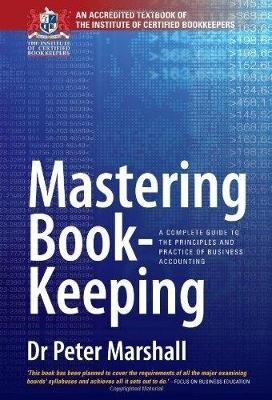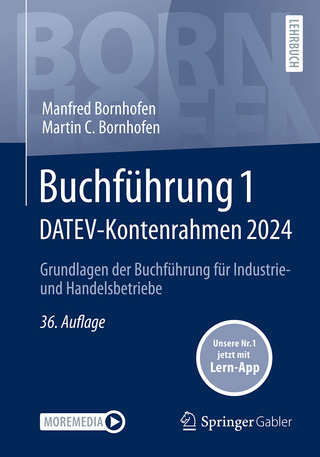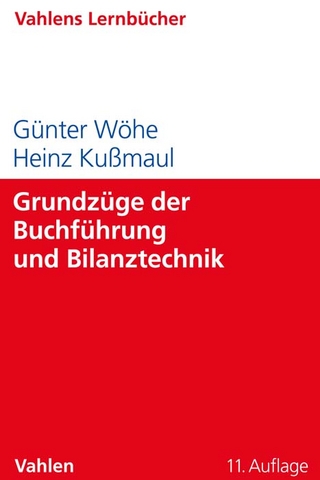
Mastering Book-Keeping 9th Edition
How To Books Ltd (Verlag)
978-1-84528-446-6 (ISBN)
PETER MARSHALL BA BSc (Econ) PhD is a professional educator in business subjects. He is also a prolific author whose books have been translated and sold worldwide.
Preface; 1. A period of transition; 2. The role and significance of the professional association; 3. Data security and the Data Protection Act 1998; 4. The flow of documents and processes; 5. What is double entry book-keeping?; 6. Opening the books of account; 7. The day books; 8. The purchase day book; 9. The purchase returns day book; 10. The sales day book; 11. The sales returns day book; 12. The cash book; 13. The cash book: money paid in; 14. The cash book: money paid out; 15. Disagreeing with the bank; 16. The bank reconciliation; 17. The petty cash book; 18 How to write up the petty cash book; 19. The journal; 20. How to write up the journal; 21. The postage book; 22. The ledger; 23. Posting to the ledger from the day books; 24. Posting to the ledger from the cash book; 25. Balancing the ledger; 26. Discounts; 27. Control accounts; 28. Preparing control accounts step by step; 29. The trial balance; 30. How to extract a trial balance; 31. The trial balance: errors; 32. Accruals and prepayments; 33. Revenue accounts; 34. Stock in the final accounts; 35. How to compile revenue accounts; 36. Compiling revenue accounts step by step; 37. The balance sheet; 38. Compiling a balance sheet step by step; 39. Manufacturing accounts; 40. Compiling a manufacturing account step by step; 41. Depreciation: the straight line method; 42. Depreciation: the diminishing balance method; 43. Other methods of depreciation; 44. Depreciation step by step; 45. Accounting for bad and doubtful debts; 46. Accounting for bad and doubtful debts step by step; 47. Partnership accounts; 48. Partnerships: appropriation accounts; 49. Partnership accounts step by step; 50. Amalgamating sole proprietorships into a partnership; 51. How to consolidate two balance sheets; 52. Limited companies; 53. Limited companies' books and accounts; 54. Format of company accounts; 55. Revenue accounts of limited companies; 56. Balance sheets of limited companies; 57. Going limited; 58 Going limited: worked example; 59. Club accounts; 60. Club accounts: income and expenditure; 61 Fixed asset register; 62. Asset disposals; 63 Asset disposals step by step; 64. Correction of errors; 65. Correcting errors step by step; Contents; 66. Value Added Tax; 67. Accounting for VAT; 68. Incomplete records; 69. Capital comparison method step by step; 70. Bank account analysis step by step; 71. Interpreting accounts; 72. Interpreting accounts: example; 73. Wages: basic principles; 74. Coin analysis and wages book; 75. Stock records and valuation; 76. Encountering deviations from standard methods; 77. Using spreadsheet pages; 78. New developments in electronic book-keeping; 79. More advanced accounting; Sample examination papers 233; ICB Level I question paper; Model answers 245; ICB Level II question paper 252; Model answers 261; ICB Level III question paper 270; Model answers 279; IAB Level 1 question paper 288; Answer booklet 311; Model answers 325; IAB Level 2 question paper 339; Answer booklet 357; Model answers 374; IAB Level 3 question paper 390; Answer booklet 401; Model answers 412; IAB Level 3 question paper 424; Answer booklet 438; Model answers 466; IAB Level 4 question paper; Answer booklet 477; Model answers 488; OCR Advanced Subsidiary GCE Accounting Principles 500; OCR Advanced Subsidiary GCE Acounting Final Accounts 502; OCR Advanced GCE Accounting Company Accounts and Interpretation 506; AQA GCE Accounting Foundation Tier, Paper 2 508; AQA GCE Accounting Higher Tier, Paper 1 513; AQA GCE Accounting Unit 2, Financial Accounting: Introduction to the Published Accounts of Limited Companies 516; AAT NVQ/SVQ Level 2 in Accounting, Preparing Ledger Balances and Initial Trial Balance 520; AAT NVQ/SVQ Level 3 in Accounting, Recording and Evaluating Costs and Revenues 524; AAT NVQ/SVQ Level 3 in Accounting, Maintaining Financial Records and Preparing Accounts 525; AAT NVQ/SVQ Standards 528; Glossary 532; Index 537.
| Erscheint lt. Verlag | 27.8.2010 |
|---|---|
| Zusatzinfo | Illustrations |
| Verlagsort | London |
| Sprache | englisch |
| Maße | 157 x 232 mm |
| Gewicht | 1032 g |
| Themenwelt | Wirtschaft ► Betriebswirtschaft / Management ► Rechnungswesen / Bilanzen |
| ISBN-10 | 1-84528-446-1 / 1845284461 |
| ISBN-13 | 978-1-84528-446-6 / 9781845284466 |
| Zustand | Neuware |
| Informationen gemäß Produktsicherheitsverordnung (GPSR) | |
| Haben Sie eine Frage zum Produkt? |
aus dem Bereich


